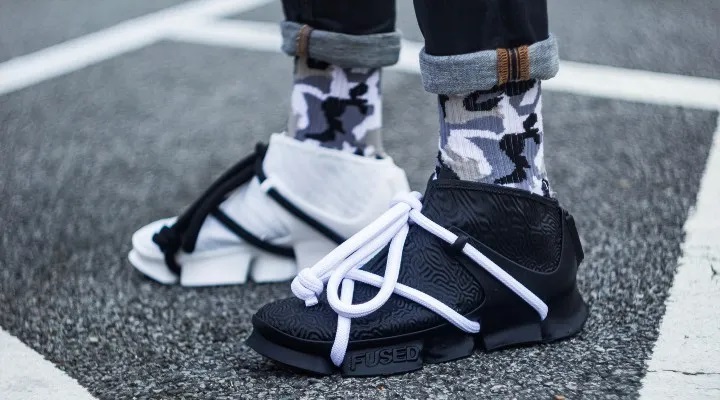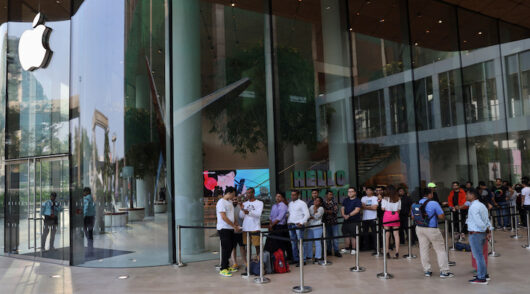Years ago, Fused Footwear founder and CEO Philippe Holthuizen did not expect to one day create 3D printed sci-fi-inspired shoes.
“I am a product designer at heart. I actually wanted to be a car designer, but I quickly realised that I [do] not have the stamina for it, so I stuck to what I know best [footwear], and I’m in a good place right now,” Holthuizen told Inside Retail.
Launched in 2017 in Hong Kong and aimed at fashion-forward early adopters, Fused Footwear offers customisable shoes that are fully 3D printed. They are currently sold online, although Holthuizen hopes to have flagship stores in every major city in the future.
“The way I see it, I’m quite happy,” he said. “I make footwear that I can stand behind, and I truly love making it.”
Prior to launching Fused, Holthuizen worked for several years at fashion-forward Dutch shoe brand United Nude, where he collaborated with high-profile designer Iris Van Herpen and British-Iraqi architect Zaha Hadid. It was in this particular role that he learnt the intricacies of the 3D printing process.
“I realised that the 3D process and shoe making in general is kind of amazing as there is a very nice balance between the design and engineering challenge of making it comfortable,” he added.
Holthuizen later joined a startup, Grom, which was mainly focused on custom-made orthopaedic footwear, where the corrective part of the sandal was 3D-printed and inserted into the sandal during the production process.
While the company soon pivoted to foot scanning solutions for podiatrists, it was then that Holthuizen was inspired to launch his own line of 3D-printed footwear.
New horizons
Fast forward to the present, Holthuizen is now pursuing his own 3D-printed footwear dreams out of a co-working space in Hong Kong.
Fused Footwear shoes are made-to-order and once printed, they require minimal finishing and are built for comfort. The design is easy to adjust for all different kinds of people, making it possible for everyone to enjoy custom-made shoes.
“All of this work that I do comes out of passion, as I was curious about how I could incorporate the 3D elements into design that captured my youthful influences from cartoons and science fiction movies,” Holthuizen explained.
Sustainability is a big part of Fused Footwear, as products are made-to-order and there is no risk of overstocking. Meanwhile, the products are made of materials that can be completely re-used by the brand to 3D print new shoes. As part of its Return 2 Recycle program, Fused Footwear encourages its customers to return their old shoes to produce new printing material and receive a 20 per cent discount off future purchases.

Capital expenditure
So far, Holthuizen has spent under $US10,000 for his operation, as he has chosen a relatively low cost 3D printing process.
As he is making the shoes in his home studio, and not like commercial brands that may need $US100,000 machines, his operations are still quite economical.
Retailing from $US145 to $US185, the Fused Footwear range is an eclectic mix of sci-fi-like designs that place comfort and utility at the heart of its designs.
Using thermoplastic materials, the products are reusable, and the “return2recycle” program is cost saving for the consumer and the brand.
“My products are 100 per cent dependent on thermoplastic, and I can take them back, shred it and repurpose it for other products, just not for new shoes,” Holthuizen explained.
The materials for the shoes are from a supplier in Mainland China. From Fused’s headquarters located in Hong Kong, delivery is swift and cost-effective.
Fundraising woes
After dealing with venture capitalists and going through the investments circuit, Holthuizen quickly discovered that software companies and technology companies always have an edge over fashion brands.
“VCs and investors are always looking for businesses that are easier to scale, and doing anything with a physical product is inherently scary for them, as they have to invest upfront, and returns could be slow,” he admitted.
Interestingly, Holthuizen feels that investors are a little bit afraid of passionate company founders, as they fear these individuals may not make commercially sensible decisions.
“Then again, passion is what drives us forward, but I do feel that is a difficult thing for investors to wrap their heads around,” he added.
Holthuizen noted that it can be difficult for some to understand the 3D printing industry and its opportunities, as they would also need to understand 3D design, 3D modelling and more importantly, the capabilities of a 3D printing machine.
The marketplace
According to Holthuizen, bigger brands are still struggling to find a way to adapt to this 3D printing paradigm.
When it comes to shoe manufacturers, the traditional processes for big brands include injection moulding and stitching. 3D printing on the other hand, does away with all of this.
“Big brands will have to build a whole new production process, and you will need new machines, and it’s still relatively expensive and slow too,” he said.
Nonetheless, 3D printing does have a lot of potential as brands can offer local production at hubs that can offer personalised and custom made products.
“There’s a guy in Germany who is mainly interested in printing 3D flexible materials and is now actually developing his own printer. His ultimate goal is to have printer farms,” Holthuizen added.
From Holthuizen’s perspective, the 3D market is still in its infancy and production is still being done at a very small scale. In his mind, scalability is the main problem for the industry and a solution to this conundrum is still a long way off.
The NFT debate
While sneaker giants like Nike are embracing NFTs and the metaverse, Holthuizen is surprisingly skeptical.
“I think there is a lot of hype there, and I don’t think there are very practical applications. It’s almost like skinning the bear before it’s shot,” he observed.
While there are a lot of customers that are passionate about these technologies and ready to invest in them, Holthuizen feels that there is going to be a lot of disappointment and frustration down the road for NFTs.
“When people realise that this thing that they are so passionate about does not really do much in the real world, that’s when they are going to realise that it was all hype and nothing more.”
Time to refocus
Western countries have always focused on service industries for various initiatives, and Holthuizen feels that it’s time for governments to focus on manufacturing capabilities again.
In the past, governments were always big investors in new technologies and offering grants to interested companies to develop new ways of doing things.
With all the talk surrounding sustainability and the circular economy, Holthuizen feels the 3D printing industry is perfectly positioned to lead the way. As Fused Footwear shoes are made to order, the business does not contribute to landfill.
“It’s time for companies to see how they can use these technologies to be beneficial for cost savings, material sourcing and also how it affects surrounding industries in a positive way,” he said.
Holthuizen feels Japan and Korea are really pushing the envelope in the 3D printing space in the APAC region, and designers from China are also making their mark in the space.
“Ideally, it would be great to see more crossovers between Asian designers and Western designers in this space, as you could see real groundbreaking concepts,” he added.






